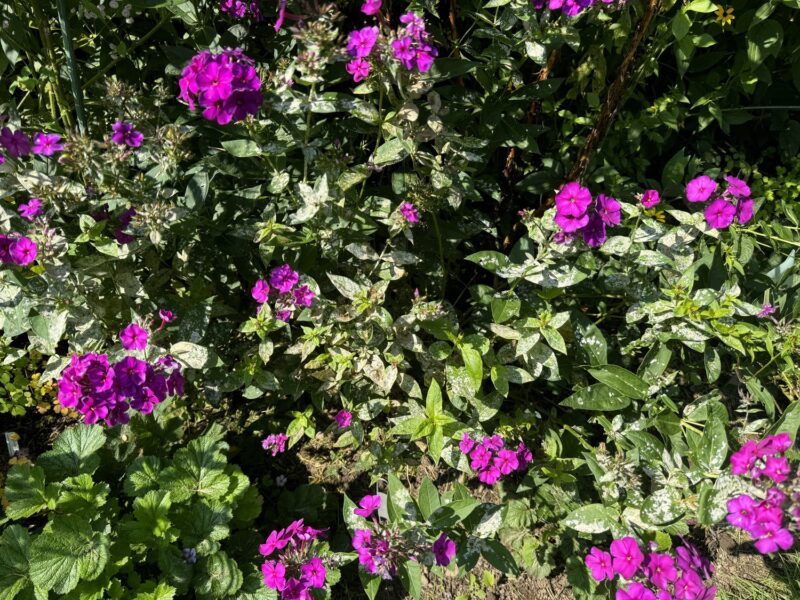

It’s late August in the garden and so far it’s been a very interesting summer. Lots of challenges, some unexpected and some routine, but this gardening season certainly is keeping us on our toes. So onward with an August ramble.
One delightful little surprise was in one of my smaller gardens. This spot is only 20 feet long and 8 feet wide on a north-facing slope, but it still gets full sun for most of the day. Being sloped, it drains quickly, though the soil is awful. A great spot for Echinacea, some native lupines and a few lengths of native sweet pea vines. But in early July I found a plant growing that had a very appealing habit.
The stems of this plant are wiry, and only three stems emerged from the crown and then extended about 2 feet tall with no branching. A few weeks later some flowers began to open revealing a five-petaled starburst flower that is close to a true red. I’m so glad I didn’t weed this plant out, and I’m still not sure why I didn’t. Turns out it’s a Silene regia, or the royal catchfly. It’s a Midwest native that is frequented by hummingbirds and black swallowtail butterflies but not all that common here.
How this single plant found my garden will forever remain a mystery, but what a wonderful gift from Mother Nature. It has sticky glands that allow it to “catch” insects, thus its common name. If you want to try this in your wildflower area you can find seed online and plants at Prairie Nursery and Plant Delights on their websites. It prefers a dry site in a rocky soil. What a treat. Thanks, Mona.
Disease-wise, gardens were doing well until we hit a spell of four weeks of hot and humid weather. Perfect for diseases, but some diseases get going in damp weather then don’t become visible for weeks later. Welcome to the world of mildews. This disease needs warm and humid weather to get started, and once it does, if the humidity and heat lasts, it can become rampant.
In the garden I see this powdery mildew on the tall garden phlox, Phlox paniculata. Nicki, a resistant variety, is covered with it. There are three species of this mildew that affect the Phlox, but it’s more important to know how to manage it than which species you have. Once established, it’s tough to control, and if not properly managed it will simply return year after year when it’s warm, wet and humid. This summer it’s been rampant on even my mildew-resistant varieties of Phlox. The gardens are especially lush this summer, reducing the air circulation in the beds, and this just exacerbates the establishment of the mildew.
There are treatments, and some organic ones are very effective. However, you must be persistent and understand how the disease spreads. Both rain, heavy dew and high humidity allow it to thrive. I’m usually proactive about mildew, and this means spraying the foliage of the phlox in late June and then following up every 10 days to two weeks, depending on the weather. Among the effective sprays are ultra fine horticultural oils, including hydrophilic neem oil, not the cold-pressed neem oil. The oils smother the spores and stop them from reproducing, but you need excellent coverage of the upper and lower leaf surfaces and stems.
Some literature says just cut the stems back — don’t. Spray.
But at the end of the season, when the foliage begins to fade, then cut the stems to the ground and remove all the stems and foliage as these will be the inoculant for next year’s infestation. As the foliage emerges next summer, begin spraying in mid-June and continue every 10 days to two weeks to be proactive. And no, the mildew species that infect garden phlox will not spread to other types of plants.
Last summer a plant showed up next to the fire hydrant at the front of the property. It had large leaves like most of the cucurbits, but the location made no sense at all. I let it be, mowed around it all summer and was gifted with a couple of very nice yellow zukes. No clue where the seed came from, but I presume the local chipmunks stashed the seed there from a neighbor’s garden and forgot about it.
This summer, another surprise. The borders about the front of the house are slightly raised with the soil held in place by old utility poles put there more than 20 years ago by the previous owners. Again, some suspect foliage emerged from a spot along one of the poles and began to extend into the a lawn. Absolutely curious as to what would emerge, I watched as large yellow flowers opened and within a day, wilted. Then one flower got pollinated and a week later a small round “melon” developed.
It became apparent that it was indeed … a pumpkin. No, I’ve never grown them on this property, so where did it come from? Then I remembered that my wife insisted on a pumpkin for Halloween last year, and when it began to disintegrate late in the fall she simply pushed the carcass off the porch onto the border at the side. Chipmunk land for sure.
Another plant mystery solved. Thanks again, Mona.
You may be expecting my seasonal remarks about your lawn. This year, something a bit different.
Late every summer I do an overseeding of my lawn. I never had any research to show that the method I use actually works though and have always wondered if it’s a wasted effort. But the lawn usually looks great (usually) so I’ve continued the practice.
I bought a used spike aerator a few years ago even though its effectiveness is minimal. The aerator gets attached to the lawn tractor, and with 50 pounds of weight on the top tray I do the aeration prior to the overseeding. First, I cut the grass very short, then aerate several times in alternating directions then apply the seed with a rotary spreader. I’ve used between 10 and 15 pounds of seed on about 2,000 square feet of lawn.
This year, however, I asked an expert. I called David Chinery, who is a turfgrass extension specialist with the Cornell Cooperative Extension up in Rensselaer County. I’ve known Chinery for years and thought it was time to ask him about my regimen since he’s done several studies on reseeding and lawn renovation.
Chinery was a bit dubious about my methods. It seems that grass seed is much more vulnerable to the vagaries of weather than I had thought. He said if the seed just lies there and there’s no rain the seed viability drops dramatically and quickly. I’d also assumed that any seed that didn’t germinate in the fall would emerge in the spring. Chinery said probably not. On the plus side I always wait to do the actual seeding until I know there will be several days of wet weather, and maybe that’s been my savior.
If you do want to try this method it’s really, really important that you try to use the same seed mix every year. Switching brands and mixes means your seed varieties may vary from year to year. Especially in the case of spot seeding small areas, those areas may look different in color or texture if the seed mix isn’t the same as the rest of the lawn.
And don’t forget: no lawn fertilizer until late in September or early October.
Insects at my place have been pretty much a nonissue this year. I’ve had nearly no Japanese beetles (12 to be precise) but I’m told by Dan Gilrein at Cornell Cooperative Extension of Suffolk County that the beetle has been rampant in local spots. My second nemesis is the scarlet lily beetle, and that’s usually a summerlong battle with one early- and one late-summer infestation. This year just a handful of them in June then none for the rest of the summer. Gilrein thinks it may be due to the release of a predator insect that has been introduced in several Northeast locations. I’m not so confident, but their absence is very curious.
And lastly, the birds. I can sit on the porch and watch my hummingbirds for hours. They’re “tanking” up now, building their muscles and body weight for the southern migration, and my feeder often has hummers in a holding pattern waiting for an available feeder port. At this time of the year I also see plenty of goldfinches as they feed on the aphids on the rose of Sharon then head over to the Rudbeckia triloba in the garden when they check the flowers hourly for ripening seed. Once the seed is ripe they glean the plants like reapers for several weeks, but the males, with their yellow body colors, blend in amazingly well with the yellow flowers. I also saw a pair of woodpeckers, maybe yellow-bellied sapsuckers, drilling away at the seed pods of the moth mullein (Verbascum) that I allow to flower in several places for their tall yellow spikes of half-inch flowers.
Then there’s my experiment with native Impatiens capensis and I. pallida. Both called jewelweed, one has an orange flower and the other a yellow flower. I thought they’d look cool in my two shaded wildflower areas on opposite sides of the property. A big mistake as they’ve seeded all over the property. Now my challenge is to get only the orange ones growing on one side and the yellows on the other side. They are called “Impatiens” for a reason, and the seed is very challenging to collect, let alone control.
So far the project is way out of hand but still in progress. The plan now is to rogue out the plants so only one color is flowering on each side of the property. Stay tuned. I fear this will be a long-term project. Keep growing.
 More Posts from Andrew Messinger
More Posts from Andrew Messinger